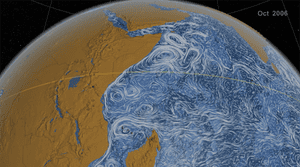Every spring a giant whirlpool – the size of Colorado – forms off the coast of East Africa. The “Great Whirl”, as it is commonly known, has long been avoided by sailors. At its peak, between June and September, the strong circular currents extend as far as 1km below the surface and the heavy waves at the surface stretch across a region 500km wide. Scientists believe that it influences the timing, size and strength of the Indian monsoon, but piracy off the coast of Somalia has prevented researchers from venturing near to the whirl to gain a better understanding of it. Now satellite data is helping us to monitor the Great Whirl.
Using satellite data going back to 1993, Bryce Melzer, from the Stennis Space Center in Mississippi, and colleagues have shown that there is great variability in when the Great Whirl forms and how long it lasts. Their results, which are published in Geophysical Research Letters, show that on average it lasts for six and a half months, but has been known to persist as long as eight months.
Now the scientists are poring over the data to look for patterns in the whirl that might help them forecast when India is likely to have a very dry or wet monsoon season.






